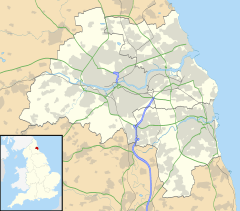Southwick, Sunderland facts for kids
Quick facts for kids Southwick |
|
|---|---|
| Population | 10,535 (2011.Ward) |
| Metropolitan borough | |
| Metropolitan county | |
| Region | |
| Country | England |
| Sovereign state | United Kingdom |
| Post town | SUNDERLAND |
| Postcode district | SR5 |
| Police | Northumbria |
| Fire | Tyne and Wear |
| Ambulance | North East |
| EU Parliament | North East England |
| UK Parliament |
|
Southwick is a lively area that used to be a small village. It is now a suburb located on the north side of the River Wear. You can find it in the city of Sunderland, which is part of Tyne and Wear. Long ago, it was part of County Durham.
From 1894 to 1928, Southwick had its own local government called the Southwick-on-Wear Urban District Council. This council helped manage the area. Later, Southwick became part of Sunderland.
Southwick shares its borders with a few other places. To the west, you'll find Castletown and Hylton Red House. To the east is Monkwearmouth. If you head north, you'll see green farmland and the area of Carley Hill. The River Wear is to the south. The Queen Alexandra Bridge connects Southwick to Pallion and the center of Sunderland.
This area has a police station that helps keep the north of Sunderland safe. There is also a primary school for younger students. However, there isn't a secondary school directly in Southwick. You can easily spot Sunderland A.F.C.'s Stadium of Light to the east, across the river in Monkwearmouth.
The heart of Southwick is its village green. This area is a busy spot with shops and three special buildings. These buildings are "listed," meaning they are important for their history or architecture. One is a memorial from World War II. Another is a pub called The Tramcar Inn, built in 1906. There is also a memorial lamp-post that was built in 1912.
Contents
A Look Back at Southwick's Past
Southwick has a long and interesting history. People have been quarrying, or digging for stone, in this area for many centuries. In the 1600s, the quarries became much larger, and they started producing a lot more stone. Special tracks called wagonways were built to move the limestone from the quarries.
Glassmaking in Southwick
Glassmaking started in Southwick in 1698 when the Suddick Glasshouse opened. This was a big step for the area. Later, in 1786, the Wearmouth Crown Glassworks began making glass too. Southwick Bottleworks was another important glass factory. It provided many jobs from 1846 until 1917.
Shipbuilding History
It's likely that ships were built in Southwick even earlier, but the first official shipbuilder was Henry Debord. He ran his business from 1785 to 1797. A well-known company, William Pickersgill & Sons Ltd, opened a shipyard in Southwick in 1845.
In 1954, this company joined with another called Austin's. After the merger, the shipyard was updated. It cost about £3 million to make it modern. The shipyard continued to build ships until it closed in 1988.
What Does "Southwick" Mean?
The name Southwick has been around for a long time. In the early 1100s, it was written as Suthewick. By the 1500s, people called it Suddick.
The name seems to mean "south dwelling" or "specialised farm." It comes from old English words. Suþ meant "south" or "southern," and wic meant "dwelling" or "specialised farm."


